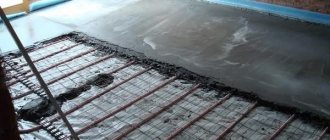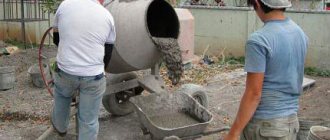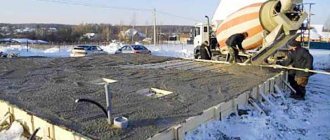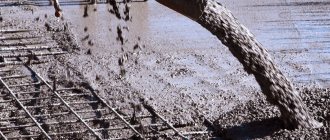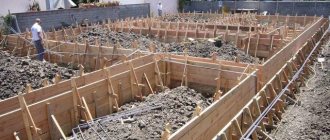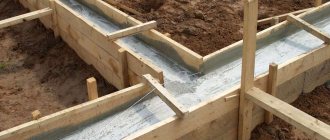Types and classification
There are four types of liquid concrete depending on the purpose of the building structure:
- Ordinary or standard - used when carrying out work on laying a foundation, laying supporting structures, reinforced concrete floors. Can be used both in the industrial sector and for private construction.
- Hydraulic engineering is an indispensable binder when arranging objects that require increased moisture resistance, for example, water supply and sewerage channels, dams, sluices, dams, as well as cellars and basements of private houses.
- For flooring and coverings - if you need to fill a garden path, a garage floor, lay a sidewalk or repair a section of a highway, then you cannot do without such concrete. The mortar is widely used to create durable airport runways.
- Special is a separate type of binder, which includes anti-radiation, heat-resistant, acid-resistant compounds. Such liquid concretes are used to create special military facilities and protective structures.
All of the above types of concrete have their own markings in accordance with GOST 7473-2010. Let's consider the meaning of the indices using the example of BSM V25 P1 F200 W4:
- BSM - means fine-grained concrete mixture;
- B25 - indicates a class of mixture with a strength of 25 (this figure for liquid concrete varies from 3.5 to 80 units);
- P1 – rolling stock. There are also rigid (R) and spreading (R) concretes;
- F200 - indicates the degree of frost resistance, namely the number of freezing and thawing cycles over the entire period of operation of the solution;
- W4 – means protection against moisture. It ranges from 2 to 20. This indicator is the main one in the construction of hydraulic structures.
Advice! If it is necessary to build durable and “movable” objects, it is better to use concrete grade P5 with improved plasticity.
All liquid concretes are conventionally divided depending on:
destinations:
- classic (regular);
- special;
- decorative;
- heat-protective;
- road (external);
type of binder (Portland cement, slag, lime, gypsum);
filler names:
- artificial;
- natural;
structural composition - depending on the type of filler, concrete with a certain density is obtained, kg/m3:
- especially lightweight (up to 500) are used more for decorative elements of buildings and thermal insulation of walls;
- light (500-1800) are used for the construction of partitions that do not bear large loads, and also as sound insulation;
- lightweight (1800-2200) – suitable for the manufacture of supports and ceilings;
- heavy (2200-2500) - for the same purposes as the previous type of concrete, but with less load;
- super-heavy (over 2500) - for special structures and foundations of multi-story buildings;
degree of hardening:
- natural hardening;
- autoclave using additional equipment.
How is the lubricant applied?
The solution is applied using a brush or spray to each mold. Before this, they are cleaned of dust and debris. Before pouring concrete, a lubricating mixture is applied. There is no need for protective suits. Wear gloves, but only to protect your hands from dirt. When spraying, it is advisable to wear a respirator. It is necessary to process the form carefully, not missing corners and crevices. The use of such a solution increases the service life.
Return to contents
Compound
The composition of liquid concrete includes 4-5 components: cement; sand; coarse filler; water; additional plasticizers (at the customer's request).
The proportions of all elements of the solution depend on the area of application of liquid concrete (Fig. 2).
Fig.2. Production of concrete of different grades from M500 cement, sand and crushed stone
The volume of water to obtain the mixture is determined depending on the degree of plasticity of the future concrete (Fig. 3).
Fig.3. Determination of water consumption (l/cub. m) depending on filler grain
What is concrete care and why is it done?
Caring for concrete involves creating such hardening conditions that:
- the concrete gained the specified strength at the required speed;
- there was no cracking of concrete for various reasons;
- by the end of the design time, the concrete or reinforced concrete structure had strength in the range in which it was specified.
What does care involve?
Caring for concrete consists of:
- ensuring such optimal conditions under which concrete is able to gain the necessary strength (providing the necessary humidity and temperature for the processes of cement hydration to occur);
- protection from the harmful effects of sun, wind and precipitation;
- protection from mechanical impacts on the structure during concrete hardening (from shock, vibration, etc.);
- limiting thermal stresses caused by temperature differences between the outer surface and the interior of the concrete structure;
Thus, concrete care comes down to solving two important problems:
- Preventing the evaporation of moisture from the surface of the concrete structure and from the concrete mixture.
- Regulation of heat release of massive concrete structures.
Liquid concrete production technology
It’s good when it is possible to purchase and deliver construction mixture to the work site. This is convenient if large-scale construction is planned. But what to do if the future building is a small building in the image of a summer kitchen or a small cozy gazebo in the courtyard of the house? In this case, you can prepare liquid concrete yourself.
For beginners who are familiar with theory but not with practice, the main task is to correctly select the proportions of all components. The construction market offers materials of the same name, but with different properties. To prepare a concrete mixture, you need to know exact information about the brand of the structural element and its quality characteristics.
Important! To get a good quality solution, you should not take elements with a high content of dust, clay and organic substances. Otherwise, the mixture will have low strength.
How to prepare liquid concrete? There are 2 methods - manual and mechanical (with a concrete mixer).
Manual method
For kneading, you can use any container, for example, an old bathtub or trough. You will also need a shovel (preferably a bayonet one) or a trowel, depending on the volume of the solution being prepared.
- pour the prepared clean sand into the trough;
- make a small depression in the center and place cement in it;
- stir the dry mixture thoroughly;
- add water, stirring until smooth;
- add filler (crushed stone);
- Mix the contents so that the filler is completely covered with the solution; add water if necessary.
Preparation of the solution
Kneading by hand
Liquid concrete is considered completely ready if there are no lumps in it and the crushed stone is hardly noticeable in the viscous mixture (covered with mortar).
Important! Once the concrete is ready, it must be placed into the mold immediately. Delay is fraught with loss of quality; the bulk will sink down, and the water will remain at the top.
Using a concrete mixer
- Connect the equipment to the network;
- Pour 2/3 of the calculated amount of water inside;
- add 1 part of the filler to the concrete mixer and rotate several times;
- pour in all the cement;
- after a few minutes of work, add the remaining sand;
- Only then pour out the rest of the crushed stone.
The solution should have the appearance of a non-liquid “semi-finished product”.
Fig.5. Using a concrete mixer
Benefits of using lubricants
Tiles are small concrete pieces that are used to lay the surface on paths. It comes in different shapes and colors and is made from different materials. But for the production of each of them, a lubricant is used. Concrete and various additives will play a major role in the quality of the tiles, but mold lubrication is also important. It is used to remove tiles to preserve their appearance. In addition, it reduces the likelihood of pores forming on the outside of the tile.
Before pouring the concrete solution into the mold, it must be cleaned of dust and debris and lubricated. Such forms are made from metal, plastic, polyurethane or wood. If the lubricant is of good quality, it will not affect the tile in any way, neither the shape nor the color. Such lubricants are produced in the form of emulsions, powder and soap solutions, oil concentrates, etc. The sample is coated with a thin layer of lubricant, and no special clothing is needed.
Return to contents
Properties and characteristics
The main property and feature of liquid concrete is its rapid “setting”, which does not allow the mixture to be stored for a long time, otherwise it will harden and become unnecessary. In addition, liquid concrete has good fluidity, which allows you to fill voids without the use of special equipment. The mixture adheres tightly to the working surface, providing maximum structural strength, especially in combination with reinforcement. These material properties make it possible to create products that can easily withstand heavy loads for a long period of time.
Characteristics of liquid concrete mortar:
- Water resistance - depends on the internal structure of the mixture: the amount of moisture, the type of filler. There are concretes that can be laid in soil with high humidity.
- Frost resistance - can easily withstand numerous temperature changes from “plus” to “minus” and vice versa.
- High strength - achieved through long-term hardening of the mixture (up to 30 days). But a concrete structure can last for several decades without collapsing.
- Plasticity - easily penetrates into large pores and internal spaces of a building structure, increasing its strength characteristics.
Kinds
Lubricants are primarily classified into:
- made from improvised materials;
- specialized.
What they have in common is that they help remove tiles.
Return to contents
Made from improvised materials
Types and their main characteristics:
- saline solution - diluted with water, low price, possibly causing stains that are difficult to clean;
- motor oil - it is applied with a sponge, it is cheap, the sample is easy to wash, it can affect the color of the tile;
- Soap solution is liquid soap, it is used to lubricate the walls; it is not easy to wash samples.
Lubricants from improvised means are especially relevant when producing small quantities of paving stones, when purchasing a special liquid is impractical. In such cases, you can go to a transport service station and buy a small amount of the product.
Return to contents
Specialized
If you need to lubricate many molds to produce large batches of tiles, you will need to purchase a special product. They come in different brands, so finding one won't be a problem.
Kinds:
- Kristal – the basis of this lubricant is light mineral oils. They are environmentally friendly and have anti-corrosion properties. The material is used for samples made of metal or wood. Application is possible either with a brush or with a spray;
- KSF-1. It has the form of a homogeneous paste. It is economical to use and easy to apply. With its help, a flat and smooth surface is obtained. The material is environmentally friendly, washes off with water. Easy to apply to plastic, metal and wood forms;
- Tiprom 90 (concentrated anti-adhesion liquid). The basis of this solution is silicones, which tend to repel water. More often used for lubricating molds (made of metal or polymer) in the manufacture of large slabs. Temperature resistant;
- Nometal. Used to protect metal forms from corrosion and cracks;
- Emulsol – made on the basis of mineral substances. Used for formwork. Apply with a sponge or spray. It's inexpensive. Used in the manufacture of paving slabs, since there is no need for grouting ;
- Agate is an economical product to use, as it has low consumption.
Lubricants are produced in concentrated solutions that must be diluted with water.
Return to contents
Examples of manufacturers
Lubricants are produced by many manufacturers in different countries. Examples:
- Italy: PTFE, DMA 1000;
- Russia: "Miskom";
- Ukraine: GOI-54P, “Budforma”.
Return to contents
Areas and features of application
The material is widely used in construction work related to the preparation of foundations and pouring load-bearing walls. Liquid concrete makes excellent garage or basement floors, as well as garden paths, sidewalks and building blind areas.
Liquid concrete is simple in composition and can be easily prepared at home for your own use. Of course, the work will require strength and energy, but buildings made from this material will last for many years without needing additional repairs.
Information sources:
- [url] GOST 7473-2010
Cast concrete
Cast concrete was developed and introduced into the construction industry at the end of the 20th century.
Cast concrete
Its main purpose is finishing of horizontal surfaces. With its use, concrete casting no longer requires labor-intensive vibration compaction, and high-quality surfaces became accessible to a basic craftsman without complex and bulky tools.
Site preparation
The key to success in concreting is the correct preparation of the site for pouring. If the mixture will be poured onto the ground, then before construction begins, its geological features should be studied, the type of soil, the degree of heaving, and the depth of freezing should be determined. This information allows designers to correctly select the type of foundation that will reliably support the frame in the event of ground movements.
During the preparation process, the site must be cleared and the top layer of soil removed. After this, the soil should be compacted, a sand and gravel cushion should be poured, and drainage should be arranged. When installing formwork, it is recommended to use only high-quality materials, since if it is not securely fastened, there is a high probability of concrete leaking out and forming internal voids.
